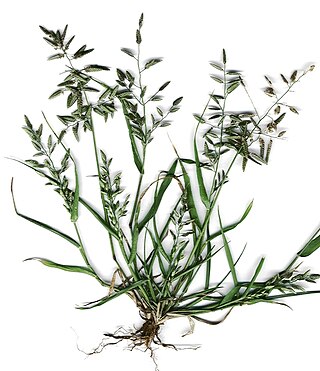
Eragrostis is a large and widespread genus of plants in the grass family, found in many countries on all inhabited continents and many islands.

Saccharum is a genus of tall perennial plants of the broomsedge tribe within the grass family.
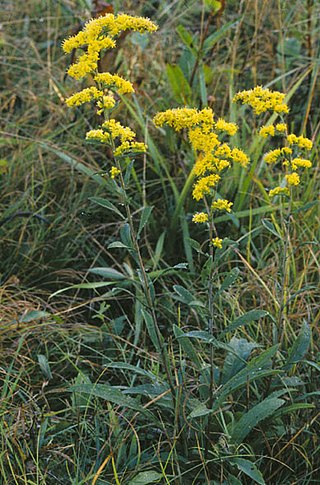
Goldenrod is a common name for many species of flowering plants in the sunflower family, Asteraceae, commonly in reference to the genus Solidago.
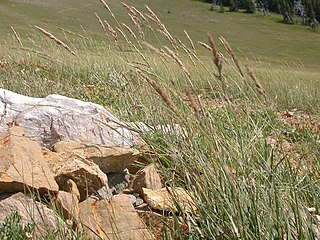
Calamagrostis purpurascens, is a perennial grass commonly known as purple reedgrass, purple pinegrass, or alpine reedgrass.

Andropogon is a widespread genus of plants in the grass family, native to much of Asia, Africa, and the Americas, as well as Southern Europe and various oceanic islands.

Sporobolus is a nearly cosmopolitan genus of plants in the grass family. The name Sporobolus means "seed-thrower", and is derived from Ancient Greek word σπόρος (spóros), meaning "seed", and the root of βάλλειν (bállein) "to throw", referring to the dispersion of seeds. Members of the genus are usually called dropseeds or sacaton grasses. They are typical prairie and savanna plants, occurring in other types of open habitat in warmer climates. At least one species is threatened with extinction, and another is extinct.

Pogonarthria is a genus of African plants in the grass family.
Acroceras is a genus of tropical and subtropical plants in the grass family.
Centrochloa is a genus of Brazilian plants in the grass family. The only known species is Centrochloa singularis, native to the states of Maranhão, Tocantins and Goiás in east-central Brazil. Some authorities consider Centrochloa to be a taxonomic synonym of Axonopus

Schizachyrium is a widespread genus of plants in the grass family. The name is derived from the Ancient Greek words σχίζειν, meaning "to split," and ἄχυρον, meaning "chaff." It refers to either the glume or the toothed lemmas.
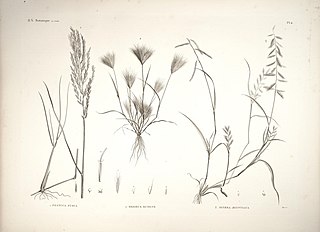
Dinebra is a genus of Asian, African, and Pacific Island plants in the grass family.
Urochondra is a genus of plants in the grass family. The only known species is Urochondra setulosa, native to northeastern Africa and southwestern Asia. The species grows in coastal sand dunes, salt marshes and estuaries.
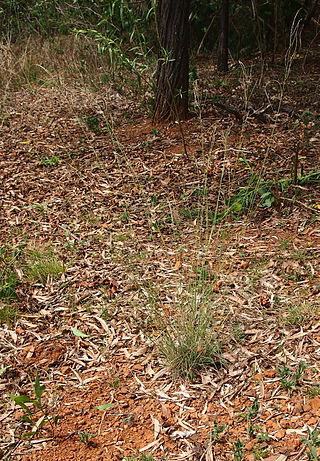
Leptochloa is a widespread genus of Asian, African, Australian, and American plants in the grass family.
Monelytrum is a monotypic genus of grass in the family Poaceae. Its sole species, Monelytrum luederitzianum is endemic to Namibia. Both common and scientific names were named for the city of Lüderitz, located in the far south of Namibia.

Cordyline congesta, commonly known as narrow-leaved palm lily is an evergreen Australian plant. A rare shrub up to 3 metres tall found on the margins of rainforest, and in riverine scrub and moist gullies in eucalyptus forest. Growing north from the Clarence River, New South Wales.
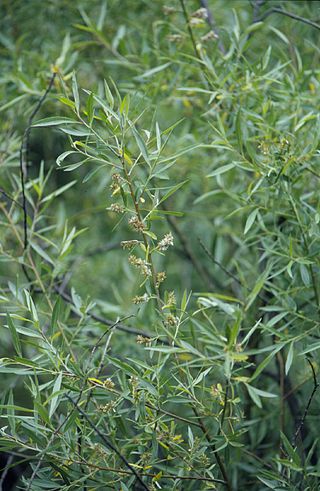
Salix geyeriana is a species of willow known by the common names Geyer's willow, Geyer willow and silver willow. The type specimen was collected by the botanist Karl Andreas Geyer, for whom it was named. Its conspicuous, yellow flowers begin to bloom as early as March, to as late as the end of June.
Castilleja beldingii is a species of hemiparasitic plant in the broomrape family, formerly the only species in the genus Clevelandia, it was moved to the genus Castilleja, the 'indian paintbrushes', in 2009.

Bothriochloa bladhii is a Neotropic grass in the family Poaceae, found primarily in tropical Africa, and tropical and temperate Asia, and Australia. The type specimen was collected from China by Finnish botanist Peter Johan Bladh. The name of Bladh is honored in the specific epithet.

Coleataenia is a genus of grasses in the tribe Paniceae of the family Poaceae. Until recently this genus was part of Panicum. In 2010, Zuloaga, Scataglini, & Morrone proposed the transfer of the Panicum sections Agrostoidea and Tenera to the new genus, Sorengia. However, that same year, because one of the new species' synonyms was in the valid genus Coleataenia, Robert J. Soreng determined that Sorengia was not a valid name for the new genus and re-published it as Coleataenia.

Dr. Charlotte M. Taylor is a botanist and professor specialising in taxonomy and conservation. She works with the large plant family Rubiaceae, particularly found in the American tropics and in the tribes Palicoureeae and Psychotrieae. This plant family is an economically important group, as it includes plant species used to make coffee and quinine. Taylor also conducts work related to the floristics of Rubiaceae and morphological radiations of the group. Taylor has collected plant samples from many countries across the globe, including Chile, Colombia, Costa Rica, Panama, and the United States of America, and has named many new species known to science from these regions. As of 2023, Taylor has authored 500 land plant species' names, the third-highest number of such names authored by any female scientist.














